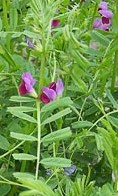 Common vetch is climbing annual vine brought to North American from southern Europe as a covercrop but has since escaped and become a troublesome weed in shrub and perennial beds in the eastern half of the United States and on the west coast. It likes full sun to partial shade and fertile, moist, well-drained soil, but tolerates less, and can be found in waste areas along roadsides and train tracks, as well as in meadows, abandon fields, and croplands. It grows quickly on the ground or over nearby plants and can weigh them down as it covers them.
Common vetch is climbing annual vine brought to North American from southern Europe as a covercrop but has since escaped and become a troublesome weed in shrub and perennial beds in the eastern half of the United States and on the west coast. It likes full sun to partial shade and fertile, moist, well-drained soil, but tolerates less, and can be found in waste areas along roadsides and train tracks, as well as in meadows, abandon fields, and croplands. It grows quickly on the ground or over nearby plants and can weigh them down as it covers them.
 Description: The stems of common vetch are weak, trailing, and climbing. They are square in cross-section and can reach 3½ feet in length. Leaves are alternate and pinnately compound, with each of the 3 to 8 leaflets being narrowly oblong, and ¾” to 1½” long. Older leaves develop tendrils that aid in climbing. Pairs of purple to rose and white flowers are produced from spring to late summer in the axis of the leaves on flowering stalks and are 3/4” to 1¼” long. They are followed by flat pods, 1½” to 3″ long, each bearing 3-12 seeds. The root system is deep and fibrous, and bears nodules that take nitrogen from the air and put it in the soil, a benefit of having this weed in your garden.
Description: The stems of common vetch are weak, trailing, and climbing. They are square in cross-section and can reach 3½ feet in length. Leaves are alternate and pinnately compound, with each of the 3 to 8 leaflets being narrowly oblong, and ¾” to 1½” long. Older leaves develop tendrils that aid in climbing. Pairs of purple to rose and white flowers are produced from spring to late summer in the axis of the leaves on flowering stalks and are 3/4” to 1¼” long. They are followed by flat pods, 1½” to 3″ long, each bearing 3-12 seeds. The root system is deep and fibrous, and bears nodules that take nitrogen from the air and put it in the soil, a benefit of having this weed in your garden.

 Control: To protect the other plants in your garden, you will probably want to hand pull common vetch as you discover it. Although its root system is deep and extensive it will not sprout if some is left behind. To prevent the spread of the weed be sure to remove it before the plants set seed. This can be done by mowing or shearing if the these procedures will not damage the plants you are trying to save. Untangling the vine from the garden plants can be quite difficult because of the tendrils, so taking control measures early in the season is recommended. The vine is an annual and will die in the winter.
Control: To protect the other plants in your garden, you will probably want to hand pull common vetch as you discover it. Although its root system is deep and extensive it will not sprout if some is left behind. To prevent the spread of the weed be sure to remove it before the plants set seed. This can be done by mowing or shearing if the these procedures will not damage the plants you are trying to save. Untangling the vine from the garden plants can be quite difficult because of the tendrils, so taking control measures early in the season is recommended. The vine is an annual and will die in the winter.